| |
 |
|
| |
 Eaton
Beauty for 1927 made by Cuno & Otto Dressel, Germany. Eaton
Beauty for 1927 made by Cuno & Otto Dressel, Germany.
|
|
| |
|
|
|
The Eaton Beauty Doll:
"The Doll We Will Never Forget"
by Evelyn Robson Strahlendorf
Over its 100-year history, the Eaton Beauty Dolls have
been
treasured by children and collectors alike. The dolls changed each year.
Details
enable owners to trace the evolution of the dolls within the context of
events
in 20th-century Canada and to identify them in their own collections.
By 1887, Eaton's catalogue was reaching Canadians from coast to
coast.
According to William Stephenson in The Store that Timothy Built:
"By
1887, barely three years after the start, he could boast it was already a
nation-wide
enterprise, rivaling his massive store as a money maker." By the end
of
the 19th century, great improvements in parcel post as well as
Eaton's
postage-paid policy on orders over $5.00 made ordering from the new
catalogues
easy.
Some of the early catalogues featured inexpensive chinahead dolls with
cloth
bodies. The china heads were also available separately; bodies could be
made
for them at home. Imported dolls that had not been seen previously were
sold
through the catalogues. Bisque heads were made of unglazed china.
"Composition"
bodies were made from a paste of fine sawdust, cornstarch, glue, and
possibly
some other ingredient. Companies had their own formulae.
| |
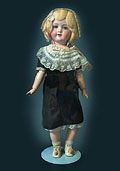 |
|
| |
 1927
Eaton Beauty, made by Armand Marseille, mould #390. The doll's original
owner, Alma Stinson, received her for Christmas and made her dress. 1927
Eaton Beauty, made by Armand Marseille, mould #390. The doll's original
owner, Alma Stinson, received her for Christmas and made her dress.
|
|
| |
|
|
|
In the 1890s, dolls with bisque heads and leather bodies became
available.
Clothing was homemade for the mostly undressed dolls. At the time, girls
had
few activities available to them and doll costuming allowed them to use
their
artistic talents and creativity. Young girls practiced their sewing skills
by
making doll clothes and made elaborate wardrobes. Sometimes they had small
trunks
in which to store their wardrobes. Girls often played with their dolls
until
they were 14 or 15 years of age.
In 1900, Eaton's catalogue introduced the first Eaton Beauty
doll. The
advertisement read: "Eaton Beauty, all jointed, special $1.00; large
sizes
from $1.50 to $10.00 each." The smallest dolls (20 inches [50.8 cm]
tall)
were a dollar, a price that was maintained until 1916. For the first five
or
six years, the bisque heads were shoulderheads (the head and shoulder
plate were
all one piece) with sleep eyes and curly mohair wigs. The shoulderheads
were
often made by Armand Marseille in Germany, model 370. The bodies were made
of
kid leather and were jointed at the knees, hips, elbows, and shoulders.
| |
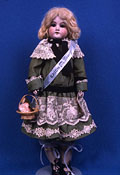 |
|
This type of doll was used
as an Eaton Beauty in 1900 and was made by Armand Marseille, Germany.
Bisque head, model #370, leather body, replaced ribbon.
|
 |
|
The 1901 catalogue listed only one 17-inch [43.18-cm] Eaton Beauty
doll. No
description of the doll is given but a fully jointed composition body doll
made
by Cuno & Otto Dressel in Germany is believed to be from 1901. It is
wearing
what appears to be the original factory-made underwear, dress, shoes, and
socks
and is complete with a red ribbon marked "Eaton Beauty" in
gold.
In the first four years of production of the Eaton Beauty, only the 1901
doll
featured the red ribbon.
| |
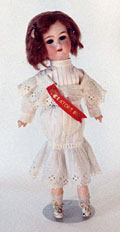 |
|
| |
 The
Eaton Beauty for 1901 was made by Cuno & Otto Dressel, Germany. Bisque
head, fully ball-jointed, papier mâché body; original
underwear, socks
and shoes, old cotton dress, may be original. The
Eaton Beauty for 1901 was made by Cuno & Otto Dressel, Germany. Bisque
head, fully ball-jointed, papier mâché body; original
underwear, socks
and shoes, old cotton dress, may be original.
|
|
| |
|
|
|
|
| |
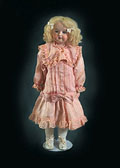 |
|
| |
 The
type of doll used as an Eaton Beauty in 1902, made by Armand Marseille,
Germany. Bisque shoulderhead, model #370, leather body. The
type of doll used as an Eaton Beauty in 1902, made by Armand Marseille,
Germany. Bisque shoulderhead, model #370, leather body.
|
|
| |
|
|
|
|
| |
 |
|
| |
 Classic
Eaton Beauty Doll made by Armand Marseille, Germany. Bisque head, model
#390, fully ball-jointed composition body. It is the only doll found
with a blue ribbon marked "EATONS"; original mohair wig, replaced chemise,
socks, and shoes. Classic
Eaton Beauty Doll made by Armand Marseille, Germany. Bisque head, model
#390, fully ball-jointed composition body. It is the only doll found
with a blue ribbon marked "EATONS"; original mohair wig, replaced chemise,
socks, and shoes.
|
|
| |
|
|
|
|
| |
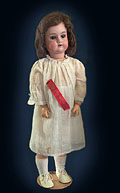 |
|
| |
 Eaton
Beauty for 1909-10 made by Cuno & Otto Dressel, Germany. Bisque head,
fully ball-jointed composition body; original chemise and ribbon. Eaton
Beauty for 1909-10 made by Cuno & Otto Dressel, Germany. Bisque head,
fully ball-jointed composition body; original chemise and ribbon.
|
|
| |
|
|
|
The choice of company to manufacture the dolls was, of course, a
business
decision and each year Eaton's chose the company that had the best
price.
In 1904 and 1905, the Beauties were made by J. D. Kestner of Germany and
had
leather bodies and bisque shoulderheads marked 15413; six or seven sizes
were
available. In the catalogues, the dolls were illustrated in line drawings,
making
it very difficult to identify the manufacturers. An Eaton Beauty with the
original
chemise and ribbon and a photograph of the doll with the delighted little
girl
who received it is the most accurate indicator that it's an
original.
In 1905, Winnipeg had a rapidly growing population of 77 000 when
Eaton's
opened a large five-storey department store and introduced a catalogue
specifically
for the influx of settlers moving through Winnipeg into Western Canada.
Like
some other merchandise, the Eaton Beauties shown in the Toronto catalogues
were
not always the same as those shown in the Winnipeg catalogues.
The 1906 and 1907 catalogues carried the Eaton Beauty Dollar Doll. Made
by
Cuno & Otto Dressel, it came in seven sizes from $1.00 to $5.00. The
red
ribbon had the Holtz Masse (wood composition) logo beside the gold Eaton
Beauty
logo.
| |
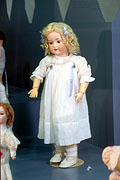 |
|
This type of doll was used
as an Eaton Beauty in 1905-1906 and was made by Armand Marseille, Germany.
Bisque head, model #390, fully ball-jointed composition body.
|
 |
|
Armand Marseille made the Beauty for the 1908-09 catalogue with
pretty
bisque heads, glass eyes, and long ringlets. Sometimes, two sisters
receiving
Eaton Beauty dolls were given dolls with different eye colour (blue or
brown)
so they could tell their dolls apart.
| |
 |
|
The Eaton Beauties for 1908
were made by Armand Marseille, Germany. Bisque heads, model #390, fully
ball-jointed composition bodies. Given to two sisters in 1908, one doll
has blue eyes, the other brown.
|
 |
|
Schoenau & Hoffmeister also made the Beauties for the 1908-09
catalogues
only; Cuno & Otto Dressel made them again for 1909-10 and
1911-12.
Armand Marseille of Germany provided the dolls for the catalogues of
1911-12,
1912-13, 1913-14, and 1914-15. During the First World War,
dolls
from Europe were not available. Luckily, the dolls had been already
purchased
for the 1914-15 fall-and-winter catalogue. The Beauties were
available
in a 27-inch size [65.58-cm] for $4.00 and a replacement head could be
ordered
for 35 cents.
| |
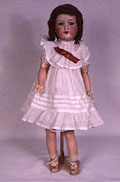 |
|
Eaton Beauty for 1913-14
made
by Armand Marseille, Germany. Bisque head, fully ball-jointed composition
body; replaced dress, original red ribbon, socks and shoes.
|
 |
|
| |
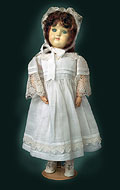 |
|
| |
 Eaton
Beauty for 1915-16 made by Dominion Toy Mfg. Co., Toronto. All composition,
fully jointed body. Eaton
Beauty for 1915-16 made by Dominion Toy Mfg. Co., Toronto. All composition,
fully jointed body.
|
|
| |
|
|
|
The Dominion Toy Manufacturing Company, a new Canadian doll
manufacturer,
was established in Toronto in 1911. It produced a very nice composition
fully
ball-jointed doll, but with a composition head, not bisque. Dominion
provided
Eaton's with the Eaton Beauties for 1915, but the sleep eyes were
not glass
and the composition heads not as beautiful as the bisque. The Eaton
Beauties
became available again in 1924 when they could be imported from
Germany.
| |
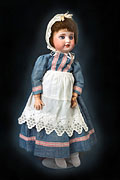 |
|
| |
 Eaton
Special Doll for 1923-24, not an Eaton Beauty was made by SFBJ, France.
Bisque head model #60, fully jointed composition body. Eaton
Special Doll for 1923-24, not an Eaton Beauty was made by SFBJ, France.
Bisque head model #60, fully jointed composition body.
|
|
| |
|
|
|
The Schoenhut all-wood dolls made in the United States were featured in
the
1917 catalogue and priced at $4.50, enough to buy a week's groceries
in
1917! Japan tried to fill the void by supplying bisque headed dolls with
Caucasian
features, but none were used as Eato Beauties.
In 1922, the catalogue showed an "Eaton's Special
Doll"
made by SFBJ in France, marked S.F.B.J./60/PARIS. Many collectors today
believe
their S.F.B.J. dolls are Eaton Beauties, but the dolls were never called
Eaton
Beauty in the catalogue.
Eaton's fall-and-winter catalogue for 1923-24 included a
"Miss
Canada Doll." She was all composition, fully ball jointed and 18
inches
[45.72 cm] tall. She was dressed in a red felt coat with white woolly
cuffs,
collar, and matching hat at a price of $2.95.
|
| |
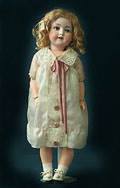 |
|
| |
 Eaton
Beauty for 1924 was made by Armand Marseille, Germany. Bisque head, model
#390, fully ball-jointed composition body. Eaton
Beauty for 1924 was made by Armand Marseille, Germany. Bisque head, model
#390, fully ball-jointed composition body.
|
|
| |
|
|
|
|
| |
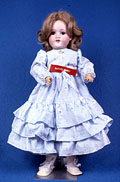 |
|
| |
 Eaton
Beauty for 1924 made by Armand Marseille, Germany. Bisque head, model
#390, fully ball-jointed composition body; replaced wig, replaced ribbon,
redressed. Eaton
Beauty for 1924 made by Armand Marseille, Germany. Bisque head, model
#390, fully ball-jointed composition body; replaced wig, replaced ribbon,
redressed.
|
|
| |
|
|
|
|
| |
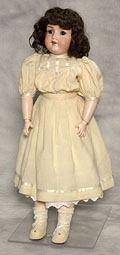 |
|
| |
 Eaton
Beauty for 1925 was made by Armand Marseille, Germany. Bisque head model
#390, fully ball-jointed composition body; redressed in old clothing. Eaton
Beauty for 1925 was made by Armand Marseille, Germany. Bisque head model
#390, fully ball-jointed composition body; redressed in old clothing.
|
|
| |
|
|
|
|
Page 2 >>
|